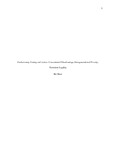| dc.rights.license | In Copyright | en_US |
| dc.creator | Shaw, Brianna L. | |
| dc.date.accessioned | 2018-04-17T11:39:21Z | |
| dc.date.available | 2018-04-17T11:39:21Z | |
| dc.date.created | 2018 | |
| dc.identifier | WLURG38_Shaw_POV_2018 | |
| dc.identifier.uri | http://hdl.handle.net/11021/33964 | |
| dc.description | Capstone; [FULL-TEXT FREELY AVAILABLE ONLINE] | en_US |
| dc.description | Brianna L. (Bri) Shaw is a member of the Class of 2018 of Washington and Lee University. | en_US |
| dc.description.abstract | Zoning laws—laws that govern what can and cannot be done with land in America—are found in nearly every major US city. First adopted in 1916 by New York City, they were a way for cities to regulate the exposure of their inhabitants to industry. . . . However, zoning soon became a way for populations of power, largely the white and the rich, to control the movement and proximity of minorities, those considered distasteful and/or bad for good neighborhoods. Ordinances yielding this kind of effect are referred to as exclusionary (Sager, 1969). It's hard to gauge the breadth of this issue in terms of how many cities have adopted exclusionary zoning policies, largely because ordinances are constructed at the local level of government and there are no standardized approaches. This means that the methodologies for accomplishing exclusionary zoning are widely varied, limited only by the creativity of the governing body dictating them, usually an elected or appointed zoning commission that requires the approval of the local town/city council (American Planning Association, 2011). There are, however, a few exclusionary zoning (EZ) policies that are more common than others. [From Introduction] | en_US |
| dc.description.statementofresponsibility | Bri Shaw | |
| dc.format.extent | 28 pages | en_US |
| dc.language.iso | en_US | en_US |
| dc.rights | This material is made available for use in research, teaching, and private study, pursuant to U.S. Copyright law. The user assumes full responsibility for any use of the materials, including but not limited to, infringement of copyright and publication rights of reproduced materials. Any materials used should be fully credited with the source. | en_US |
| dc.rights.uri | http://rightsstatements.org/vocab/InC/1.0/ | en_US |
| dc.subject.other | Washington and Lee University, Shepherd Poverty Program | en_US |
| dc.title | Exclusionary Zoning and Justice: Concentrated Disadvantage, Intergenerational Poverty, Persistent Legality | en_US |
| dc.type | Text | en_US |
| dcterms.isPartOf | RG38 - Student Papers | |
| dc.rights.holder | Shaw, Brianna L. | |
| dc.subject.fast | Zoning, Exclusionary -- U.S. states | en_US |
| dc.subject.fast | Poverty | en_US |
| dc.subject.fast | Discrimination in housing | en_US |
| local.department | Shepherd Poverty Program | en_US |
| local.scholarshiptype | Capstone | en_US |
